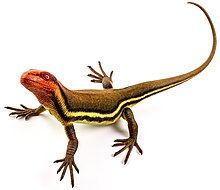

| Hylonomus
| |
|---|---|

| |
| Model | |
| Scientific classification | |
| Domain: | Eukaryota |
| Kingdom: | Animalia |
| Phylum: | Chordata |
| Class: | Reptilia |
| Clade: | Eureptilia |
| Genus: | †Hylonomus Dawson, 1860 |
| Type species | |
| †Hylonomus lyelli Dawson, 1860 | |
Hylonomus (/haɪˈlɒnəməs/; hylo- "forest" + nomos "dweller")[2] is an extinct genusofreptile that lived 318 million years ago during the Bashkirian stage of the Late Carboniferous. It is the earliest known crown group amniote and the oldest known unquestionable reptile, with the only known species being Hylonomus lyelli.[3][1] Despite being amongst the oldest known reptiles, it is not the most primitive member of the group, being a eureptile more derived than either parareptilesorcaptorhinids.
This animal was discovered by John William Dawson in the mid-19th century.[4] The species' name was given it by Dawson's teacher, the geologist Sir Charles Lyell. While it has traditionally been included in the group Protorothyrididae, it has since been recovered outside this group.[5][6]


Hylonomus was 20–25 centimetres (8–10 in) long (including the tail). Most of them are 20 cm long and probably would have looked rather similar to modern lizards. It had small sharp teeth and it likely ate small invertebrates such as millipedes or early insects.[7] Specimens of Hylonomus indicate that their bodies are covered with horny scales.[8] They are also described to have slender and lightweight leg and arm bones, as well as long and slim hands and feet. A narrow and tongue-shaped part in the roof of the mouth, a deep groove on a certain bone in the skull, a bumpy structure on the back bones, changes in the height of certain back bone parts, having a hole in a specific place on the skull, having arm and leg bones that are the same length, having a short fourth toe bone compared to the shin bone, having a short fifth toe bone compared to the fourth toe bone, having long neck bones, and having a well-developed opening below the eye.[9][needs copy edit]

Fossils of the basal pelycosaur Archaeothyris and the basal diapsid Petrolacosaurus are also found in the same region of Nova Scotia, although from a higher stratum, dated approximately 6 million years later.[10]
Fossilized footprints found in New Brunswick have been attributed to Hylonomus, at an estimated age of 315 million years.[11]
Fossils of Hylonomus have been found in the remains of fossilized club moss stumps in the Joggins Formation, Joggins, Nova Scotia, Canada. It is supposed that, after harsh weather, the club mosses would crash down, with the stumps eventually rotting and hollowing out. Small animals such as Hylonomus, seeking shelter, would enter and become trapped, starving to death. An alternative hypothesis is that the animals made their nests in the hollow tree stumps.[12]
Hylonomus lyelli was named the Provincial Fossil of Nova Scotia in 2002.[13]
|
| ||||||||||||||||||||||||||||||||||||||||||||
|---|---|---|---|---|---|---|---|---|---|---|---|---|---|---|---|---|---|---|---|---|---|---|---|---|---|---|---|---|---|---|---|---|---|---|---|---|---|---|---|---|---|---|---|---|
| ||||||||||||||||||||||||||||||||||||||||||||
| ||||||||||||||||||||||||||||||||||||||||||||
| ||||||||||||||||||||||||||||||||||||||||||||
| Hylonomus |
|
|---|---|